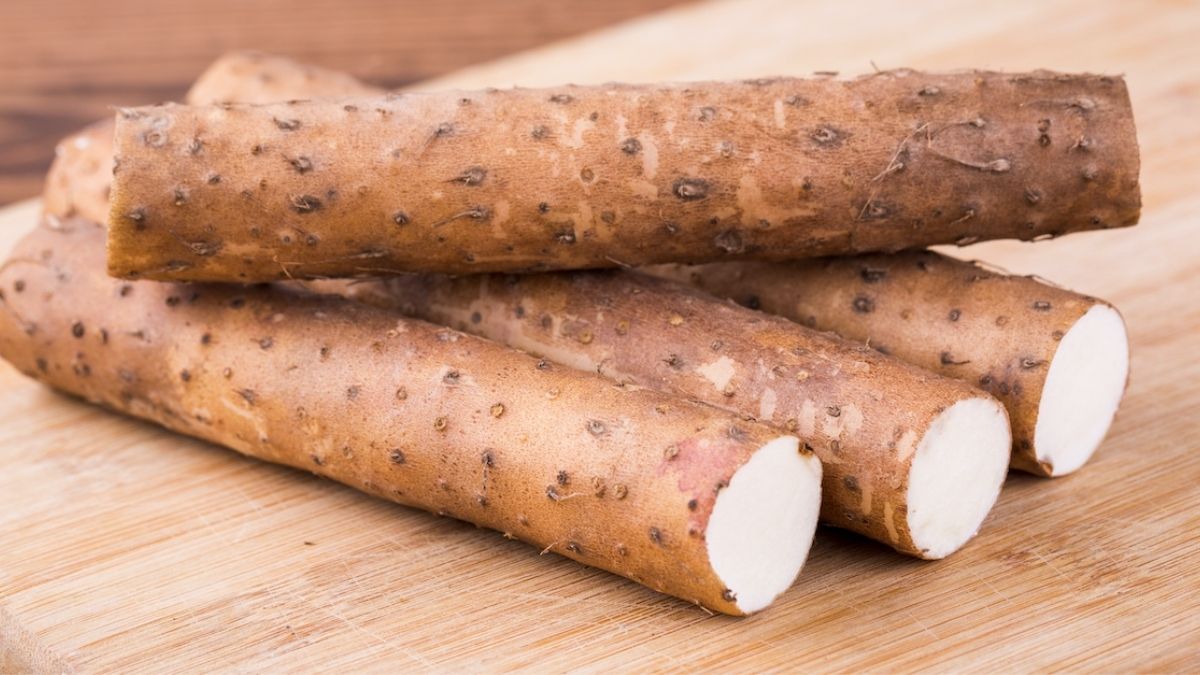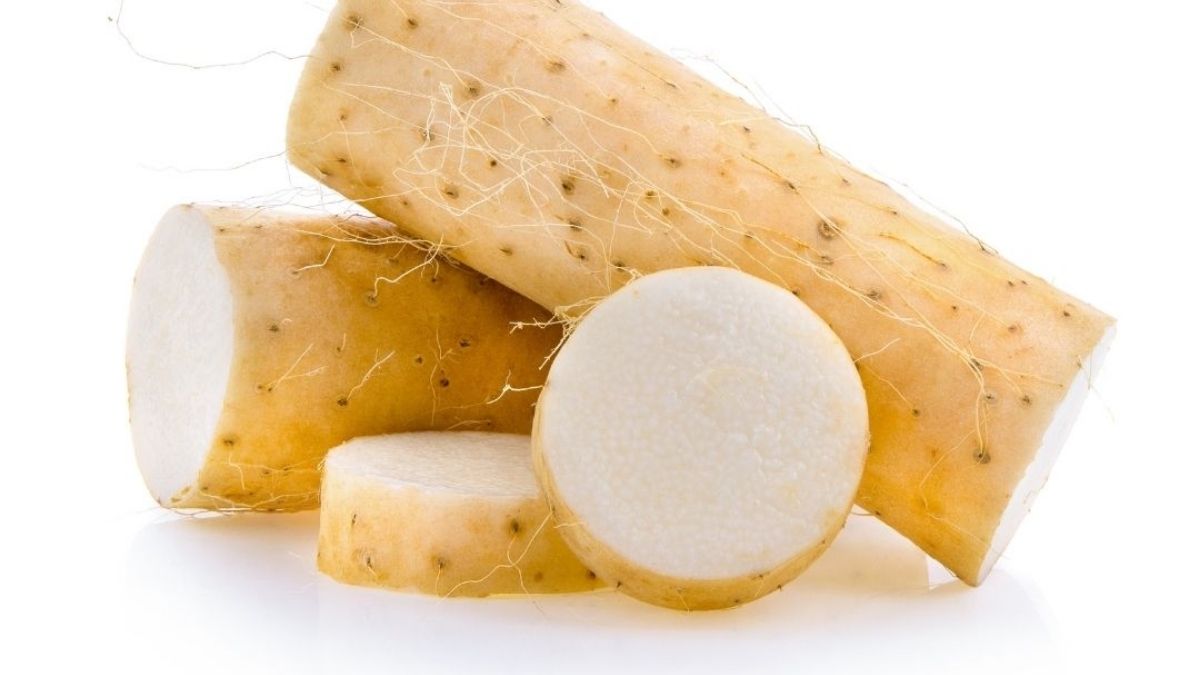Nagaimo and its wild mountain cousin, yamaimo, have slightly different tastes, textures, and shapes, but they are both cut up and grilled or eaten raw in the same way. The raw nagaimo is grated into a sticky cream called Tororo. To add flavor, Tororo can be put on rice, soba, or udon noodles or mixed with dashi (fish stock). When raw nagaimo touches some people’s skin, it can cause a mild reaction.
This can make the lips feel like they are tingling. Other tubers, like taro or cassava, must be cooked before they can be eaten. But nagaimo can be eaten both raw and cooked. Handling raw nagaimo without gloves can irritate the skin. Nanaimo has a mild sweetness like jicama and a texture like taro, but it is less starchy. It is delicious when pan-fried until the outside is brown and crisp and the inside is soft and tender.
What is Nagaimo?
Nagaimo is a type of yam grown in East Asia. It is also called Chinese yam, Korean yam, Japanese mountain yam, or yamaimo. The pale yellow skin and fine white hairs on these long, thin yams make them easy to spot. Raw nagaimo tastes mild and sweet, and it has a slimy texture like okra. Nagaimo can be used to top salads, soups, noodle dishes, and stir-fries or thicken them.
Nagaimo is a type of root vegetable in the Dioscoreaceae family. There are three main types of “yamaimo” (Dioscorea japonica) yams: yamaimo, jinenjo (Japanese yam), and Saijo (water yam). Yamanoimo has been eaten in Japan for a very long time. Nagaimo has a unique texture when it is grated and left raw. Nagaimo takes simple rice and noodles and turns them into special treats like mugitoro-Gohan (a bowl of boiled rice and barley with grated yam on top) and Tororo soba (buckwheat noodles served with grated yam on top). Nagaimo is not only delicious, but it is also very healthy and good for you.
How to Eat Nagaimo?
4 Ways to Eat Nagaimo
Nagaimo can be used in many Japanese recipes, eaten on its own, or added to soups, stews, and sushi handrolls to give them a different texture.
- As an appetizer or side dish- Nagaimo salad is a simple dish made of raw slices of yam dressed with Shyu (soy sauce) and a variety of toppings, such as katsuobushi (dried bonito flakes), shredded nori, and shiso leaves.
- 2. As a topping- Pulpy, grated nagaimo, also called Tororo, is a common ingredient in noodle dishes like ramen, udon, and Tororo soba (nagaimo served over buckwheat soba noodles). The yam also makes a great topping for rice dishes like Tororo Gohan, grated nagaimo on steamed rice with a raw egg, and soy sauce drizzled on top.
- As a thickener, grated nagaimo’s starchy stickiness is ideal for foods like okonomiyaki, cabbage, and egg-based savory pancake eaten all over Japan. Adding a bit of Tororo to the wheat flour batter gives the pancake a light, fluffy texture.
- In stir-fries- When you pan-fry slices of nagaimo, the flesh becomes smooth and sweet, and its mild flavor makes it easy to pair with other, stronger flavors in a stir-fry.
How to Prepare Nagaimo?
Most Asian grocery stores have nagaimo that is already whole, and other tubers, like taro or cassava, must be cooked before being eaten. But nagaimo can be eaten both raw and cooked, except handling raw nagaimo without gloves can irritate the skin.
First, use a vegetable peeler to take off the skin to get ready. Then, cut it into small pieces or matchsticks, eat it raw with a dressing or seasoning, or fry it in a pan until it’s golden brown and crisp. You can also grate nagaimo (carefully, since the exposed flesh is slippery) with a Microplane or box grater to use as a condiment, topping, or base for a loose patty.
What are the Health Benefits of Nagaimo?
Yams are one of the vegetables with the most flavor. Yams are a root vegetable that has been around for a long time, and they have also been used in alternative medicine for a long time. The benefits of yam come mostly from its roots and rhizomes.
1. May Promote Skin Health
Yams have a lot of diosgenin, a plant steroid that keeps women’s skin from getting older during menopause. In-vivo animal studies on mice have shown that diosgenin improves the thickness of the skin on ovariectomized mice without changing the amount of fat that builds up.
2. May Aid Weight Loss
A fiber made from the roots of yam, called glucomannan, may help people lose weight. At 2–4 g per day, this fiber forms a gel that stays in the stomach and makes you feel full. It can make you less hungry and help you lose weight in the long run.
3. May Promote Fertility
Hormone replacement therapy is becoming more common with natural hormones. Some women find that creams with wild yam extracts work best for them. Most “natural” progesterone comes from Dioscorea uillosa, a wild yam that grows in Mexico but can’t be eaten.
4. May Relieve Menopause Symptoms
Diosgenin, which can be found in wild yam, is used to treat problems with sex hormones. It is also used to make birth control pills and treat menopause and premenstrual syndrome. A study done at the Baker Medical Research Institute in Australia found that this substance could relieve menopausal symptoms without causing any side effects.
Traditional medicine knows that yams have important compounds to help menopause and premenstrual syndrome. Also, a study done at the National Taiwan Normal University showed that postmenopausal women who eat yam could improve their levels of sex hormones, lipids, and other antioxidants.
5. May Aid Diabetes Treatment
Diabetes happens when insulin isn’t made enough (or from increased cellular resistance to insulin). A study on rats showed that yam could help improve the way glucose is used in the body.
Also, the sugar in yams makes your meals naturally sweet and cuts down on your desire for sugar. Oxidative stress can be changed by yam and its active ingredient, allantoin. They also help the liver work better, which keeps insulin and glucose levels stable.
6. May Fight Inflammation
Saponin is found in large amounts in the outer bark of the wild yam root. Saponins might help fight pain and swelling. So, yams may help fight inflammation and help your abdominal and pelvic muscles relax (and even heal). Saponins’ ability to fight free radicals may also help reduce inflammation caused by many diseases.
7. May Help Prevent Cancer
A study on rats showed that the diosgenin in yams could stop cancer from starting by acting as an antioxidant and anti-inflammatory. The study concludes that yam can be used as a cancer drug. The same study also found that eating a lot of yams can slow the growth of colon tumors by a lot. But more research needs to be done in this area to determine how yams affect people.
8. May Enhance Brain Function
Potassium is found in a lot of yams. Potassium makes nerves in the brain work better and helps the brain think. Yams also have a lot of diosgenin, a unique chemical that is good for the brain and helps neurons grow.
9. May Improve Digestive Health
Yams are full of good things for your digestive health, like resistant starches, soluble glycoprotein, and dietary fiber. Studies have also shown that yams may cause gastric epithelial cells to multiply and increase the activity of digestive enzymes in the small intestine.
Can you Freeze Nagaimo?
Nagaimo can be found in the produce section of Japanese or Asian supermarkets. You can cut it into small pieces, wrap each piece in plastic wrap, put it in a freezer bag, and store it in the freezer for up to a month. If you always use nagaimo that has been grated, you can also grate it before freezing. Nagaimo doesn’t last very long for a yam. It should be kept dry, cool, and out of the light. The whole nagaimo is often shipped in sawdust, but you can keep it for about two weeks in the fridge or another cool place if you wrap it in the newspaper. After being cut, it should be kept in the fridge and used within a week.
What Is a Substitute for Nagaimo?
Some readers claim that grated potato can be substituted for grated nagaimo in the Okonomiyaki recipe. However, after trying it myself, I have to disagree (read the post). In the piece, I suggested a few better substations. We may also use grated taro, but don’t eat it raw and make sure it’s cooked. The only alternatives to nagaimo, yamaimo, or yamaimo, are much more difficult to come by outside of Japan. Any quality Japanese grocery store should have raw nagaimo, which I can obtain in my small local Japanese grocery. Instead, you can use dried yamaimo powder.
Conclusion
The nagaimo doesn’t have much of a flavor, and it has a slightly nutty flavor that brings out the taste of each grain of rice. The thing that makes it interesting is how slimy it is. Nagaimo tastes mild and sweet, and it has a slimy texture like okra. Nagaimo is a mountain yam with light-colored skin and hairy roots that can be eaten raw. It is used to make Okonomiyaki, Tororo Soba, Tororo Gohan, and other dishes. Raw nagaimo tastes mild and sweet, and it has a slimy texture like okra. Nagaimo can be used to top salads, soups, noodle dishes, and stir-fries or thicken them.


